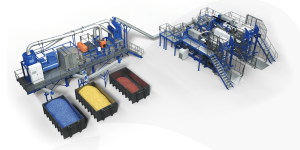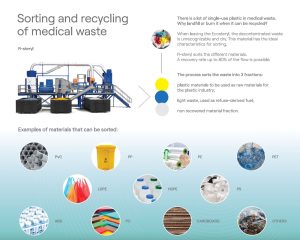Every day, tonnes of infectious healthcare waste are generated in hospitals, clinics, laboratories, care homes, and even private homes. Behind a seemingly harmless used needle or soiled dressing may lurk invisible yet formidable pathogens. Hepatitis, HIV, antibiotic-resistant staphylococci… the dangers are real and often underestimated. In a global context of heightened health vigilance, understanding and controlling these risks has become a public health priority.
Waste unlike any other
Not all waste resulting from healthcare activities is created equal. Infectious Healthcare Waste (IHW) – in French, Déchets d’Activités de Soins à Risques Infectieux (DASRI) – includes materials that may contain microorganisms capable of causing infections in humans or animals. This waste is produced in various environments: hospitals, GP surgeries, vaccination centres, diagnostic laboratories, and also during home care procedures.
It includes used needles, syringes, catheters, dressings, gloves, swabs, contaminated test tubes, and even anatomical parts. Its handling requires utmost care, as improper disposal or contact can expose individuals to potentially incurable infections.
Transmission methods: infection at your fingertips
The key danger of IHW lies in its capacity to transmit infectious agents. Unlike household rubbish, this material can remain hazardous for hours or even days, depending on the conditions.
Contamination may occur in several ways:
- Through needlestick injuries or cuts from contaminated sharp objects.
- Through contact with broken skin or mucous membranes, particularly when handling waste without protection.
- Via projection or splatter of biological fluids during transport or sorting.
- By inhalation of contaminated aerosols during certain treatments or when opening non-compliant waste bags.
Each unprotected action can therefore turn into the starting point of a preventable infection.
Silent but serious diseases transmitted through hospital waste
A number of infections can be contracted via IHW. Some are well-known to the general public, while others are less so. Below is a summary of the main infectious risks identified in healthcare field:
| Pathogen | Associated disease | Mode of transmission |
|---|---|---|
| Hepatitis B virus (HBV) | Hepatitis B | Blood, needlesticks, skin contact |
| Hepatitis C virus (HCV) | Hepatitis C | Blood, needlesticks |
| Human Immunodeficiency Virus (HIV) | AIDS | Blood, bodily fluids, needlesticks |
| Methicillin-resistant Staphylococcus aureus (MRSA) | Nosocomial infections, sepsis | Skin contact, aerosol |
| Mycobacterium tuberculosis | Tuberculosis | Aerosol, indirect contact |
| Clostridium difficile | Infectious colitis | Faecal contact via contaminated objects |
| Candida albicans | Fungal infections, opportunistic infections | Contact, immunosuppression |
The most exposed professions, those most in contact with medical waste
Contrary to popular belief, doctors are not the only ones at risk. Many incidents involving IHW affect professionals who often work behind the scenes:
- Nurses and care assistants, who handle waste directly at its source.
- Cleaning and waste collection staff, often less trained yet in daily contact with IHW.
- Waste treatment technicians, responsible for sterilisation, transport, or shredding.
- Patients and home caregivers, particularly when self-care procedures are poorly supervised.
According to the World Health Organization, more than 2 million sharp-related injuries are reported each year among healthcare professionals worldwide, resulting in approximately 66,000 hepatitis B infections, 16,000 hepatitis C cases, and 1,000 HIV infections.
Prevention, training, innovation: pillars of responsible management
To mitigate these risks, several key measures exist and must be deployed at all levels of the care and waste management chain.
- Use standardised, secure containers
IHW must be disposed of immediately after use into rigid, leak-proof, sealed and certified containers to prevent spills or accidental injury. - Educate and raise staff awareness
Regular, role-specific training is essential to reinforce good practices, safety protocols, and the importance of correct sorting. - Adopt eco-friendly treatment technologies
Incineration, long used as a disposal method, is now criticised for its pollutant emissions. Innovative alternatives exist: machines developed by companies like Ecosteryl use a combination of microwaves and dry shredding to effectively neutralise pathogens — without combustion, water, or toxic emissions.
These solutions not only significantly reduce the medical sector’s carbon footprint but also ensure biosafety by sterilising infectious waste thoroughly.
A shared responsibility for global health
The management of infectious medical waste is a silent but vital challenge. It calls upon the responsibility of healthcare institutions, public authorities, manufacturers, and each healthcare worker. By reducing transmission risks, adopting sustainable technologies, and fostering a culture of prevention, we can ensure that medical waste does not become a vector of contamination.
At a time when health systems are under strain from pandemics, economic crises, and environmental pressures, rethinking how we handle IHW is more than just a necessity — it’s a commitment to global health.
Sources :
- World Health Organization (WHO) – Healthcare Waste Management
- INRS France – Risks Related to Healthcare Waste
- Institut Pasteur – Hepatitis B and C Transmission
- French Ministry of Health – IHW Management Guide
Just like in any specialised field or professional sector, the world of medical waste management comes with its own language and specific terminology. However, these terms can vary significantly depending on the country, continent, language, or culture. This is especially true for infectious medical waste—a subcategory of medical waste treated by Ecosteryl machines. Despite differences in terminology, the classification principles for infectious medical waste are broadly similar: they all refer to healthcare-generated waste that poses a biological contamination risk (e.g. blood, dressings, needles, etc.).
Royal Mission to Vietnam: Olivier Dufrasne, President of Ecosteryl, was involved in it for sustainable medical waste managementBelgium recently marked a significant milestone in its diplomatic relations with Vietnam through a state visit led by the Belgian royal couple. This mission brought together political, economic, and academic figures, with a strong presence of Belgian business leaders and experts in sustainable development and waste management. Among these experts, Olivier Dufrasne, President of Ecosteryl, actively participated in discussions about innovative solutions for medical waste management—an issue of critical importance for Vietnam.
Zoomlion revolutionizes medical waste management in Ghana with 6 Ecosteryl unitsIn Ghana, as in many countries, managing medical waste is a major challenge. Too often, this waste ends up in open dumps, exposing the population to serious health and environmental risks. During the COVID-19 pandemic, the volume of medical waste skyrocketed, emphasizing the urgent need for rigorous and sustainable waste management. Today, with six operational Ecosteryl 125 units, a decisive turning point has been achieved thanks to Jospong Group of Companies and its subsidiaries, Zoomlion and Medical Waste Treatment Facility, in collaboration with the Ghanaian government. State-of-the-art medical waste treatment centers are now operational in several regions of the country.
A vital issue: properly managing medical waste
Every year, nearly three million injuries and infections are recorded worldwide in hospitals and landfills where this waste is abandoned. It is not uncommon to see children playing with used syringes or blood-stained materials, posing major hazards. Exposure to pathogens endangers not only their health but also their future. During the COVID-19 pandemic, the situation worsened. The Ghanaian government then made a historic decision: to establish dedicated medical waste management infrastructure across the country. This is how the collaboration with Ecosteryl was born. The goal: to have clean, safe, and environmentally friendly medical waste treatment centers.
Project History:
In 2021, under the leadership of Ghanaian President Nana Addo Dankwa Akufo-Addo, the government initiated a visionary project: the creation of specialized medical waste treatment centers in every region of the country. Jospong Group of Companies, through its subsidiary Zoomlion, in collaboration with the state, chose Ecosteryl technologies, recognized for their efficiency and environmental friendliness.
The partnership materialized with the acquisition of six Ecosteryl 125 units, capable of processing up to 20 tons of waste per day. A strategic choice that eliminates health risks without water or incineration, thereby avoiding toxic emissions responsible for respiratory and cardiovascular diseases, and even cancer, while also conserving precious water resources.
The installation of these machines was accompanied by intensive training. Mr. Ing. Senam Tengey, in charge of the project, and his team of five technicians spent several weeks at Ecosteryl’s facilities in Mons to understand medical waste challenges and the full operation of our machines. Our teams then traveled to Ghana to ensure installation and on-site operator training.
Zoomlion’s goal: the entirety of Ghana by the end of 2025
Zoomlion is already present in seven regions of Ghana and aims to cover the entire nation by the end of 2025.
The Kumasi treatment center is one example. We were present at its inauguration.
At the Kumasi treatment center, medical waste is perfectly managed through the following steps:
- Infectious waste is collected from healthcare facilities and transported to the center.
-
It is temporarily stored in a cold room at 4°C or lower to prevent bacterial growth.
-
The waste is weighed and then transferred to a four-shaft shredder, reducing it to pieces smaller than 3 cm.
- It then goes through a microwave system, where it is rapidly heated to reach 100°C in less than three minutes.
- Next, it is maintained at this temperature for one hour in a heat retention tank using an electric resistance system.
-
The waste emerges dry, shredded, unrecognizable, and disinfected to a 6log10 level. All bacteria, viruses, and other pathogens are eliminated.
Unlike incineration, this process produces no dioxins, furans, or other toxic emissions. The goal is to transform this waste into resources, contributing to a circular economy.
Everyday heroes on the front lines of medical waste management
Behind these cutting-edge infrastructures are dedicated men and women on the front lines, safeguarding the population and the environment. Every day, they collect and process hazardous waste, reducing disease risks and limiting environmental impact.
As project manager Mr. Ing. Senam explains:
“Since the establishment of the Kumasi treatment center, medical waste management has significantly improved. Our teams are now equipped to ensure safe and eco-friendly treatment, and we encourage all healthcare facilities to join us.”
An initiative that inspires africa and the world
This project, already cited as a model to follow, paves the way for similar initiatives across other African countries. It demonstrates that with determination, expertise, and strong partnerships, it is possible to turn a health challenge into an opportunity for a cleaner and healthier future.
The Ecosteryl process is based on high-performance electrical technology, easy to use, effective, and entirely eco-friendly.
A winning system on all fronts:
- An ideal solution for the healthcare sector, allowing safe waste disposal.
- A strong commitment to the environment, with zero pollutant emissions.
- Effective disease prevention by limiting exposure to pathogens.
Congratulations to the teams on the ground and Jospong Group of Companies for this exemplary achievement!
Do you also want to change medical waste management in your part of the world?
Contact us at sales@ecosteryl.com
Five years ago, an invisible threat disrupted our world, shedding light on many aspects.
Beyond buying toilet paper in large quantities, cleaning our groceries with brushes, and checking on what the neighbor was doing, we mainly ensured not to get infected and to care for those who were. The essential returned to the center of our concerns: our health. And, of course, the crucial role of healthcare workers and our healthcare system. Additionally, the management of our medical waste, which was itself infected.
The COVID-19 pandemic led to an unprecedented increase in healthcare-related waste: personal protective equipment (PPE), tests, syringes… A true surge of biomedical waste that strained waste management systems worldwide. Remember, we were all masked, and masks were expensive. According to the WHO, between March 2020 and November 2021, over 87,000 tons of PPE were distributed, generating a major environmental challenge. So, what do we take away from this crisis today?
Valorizing disinfected medical waste: it’s possibleAlthough often perceived as a burden, medical waste can actually be a valuable resource when properly managed and valorized. Its composition generally contains highly sought-after materials with specific recycling potential, making it highly attractive to the plastics and recycling industries. Sorting this waste efficiently can therefore be highly both environmentally and financially beneficial.
To facilitate this, Ecosteryl has developed a process that is unique worldwide: R-Steryl sorting center. Combined with Ecosteryl’s range of machines, this highly efficient sorting center enables the separation of processed medical waste for the valorization of its different fractions. Beyond the ecological and environmental benefits, investing in a sorting solution can also be highly profitable, creating a new source of revenue.
Envision a disinfected medical waste turning into an everyday object such as a lamp, a vase, or urban furniture, or even forming the base of a new waste bin. This scenario is not only entirely conceivable but also actively encouraged within a sustainability and circular economy framework. Disinfected medical waste—primarily composed of plastics—can have a valuable second life.
 Transforming waste from an ignored byproduct into a valuable resource requires only a ‘technological’ step, which Ecosteryl enables with its sorting center. By combining aeraulic and optical sorting processes, R-Steryl extracts high-purity materials from medical waste streams, maximizing both efficiency and profitability.
Transforming waste from an ignored byproduct into a valuable resource requires only a ‘technological’ step, which Ecosteryl enables with its sorting center. By combining aeraulic and optical sorting processes, R-Steryl extracts high-purity materials from medical waste streams, maximizing both efficiency and profitability.
• Reduce landfill and incineration costs
- Polypropylene (PP)
- Polyethylene (PE)
- Polyvinyl chloride (PVC)
- Polycarbonate (PC)
- Acrylonitrile-butadiene-styrene (ABS)
- Expanded Polystyrene (EPS)
- Paper and cardboard
 The selected plastic polymer, or a blend of selected polymers, can be used in various production processes, including but not limited to:
The selected plastic polymer, or a blend of selected polymers, can be used in various production processes, including but not limited to:
- Manufacturing plastic tubes and pipes for irrigation and electrical applications
- Producing plastic containers and bottles
- Manufacturing waste bins
- Packaging materials
- Textile industry applications
- Manufacturing benches, chairs, and various furniture items
Sorting fractions and valuation
R-Steryl separates waste into three main fractions, each with a specific valuation:
1. Light fraction:
Composed of light plastic films, cotton, and textiles, the light fraction can be reused as Solid Recovered Fuel (SRF). This process converts non-hazardous dry waste into an energy source. Due to its high calorific value, SRF is highly valued by industries with high-capacity furnaces, such as cement manufacturers.
Consisting of dense plastics (PET, PE, PP, PVC), syringes, and needles, this fraction is further divided into:
-
-
This fraction is sorted by selecting specific materials or a mixture of materials, with the possibility of specifying colors and sizes. The sorted plastic fraction is chosen based on the initial nature of the waste.
-
For example, only yellow PP under 3 cm may be selected.
Recovered materials are reused as raw materials in various recycling industry processes.
-
- This fraction may either be discarded in a landfill or re-sorted. It can be recirculated within the R-Steryl system or processed further using multiple optical sorters. Alternatively, it can be sent to specialized sorting centers for additional treatment.
Aeraulic and optical sorting system
How does this work? By combining aeraulic separation and an optical sorting system, R-Steryl separates disinfected medical waste based on density, material type, color, and size, achieving unparalleled levels of efficiency and purity.
 Aeraulic Separation: This system separates materials based on density differences between light and heavy components. Using a zigzag screen, a fan, and a cyclone, it recovers the light fraction while enhancing the quality of the heavy fraction, which is then sorted by the optical sorter.
Aeraulic Separation: This system separates materials based on density differences between light and heavy components. Using a zigzag screen, a fan, and a cyclone, it recovers the light fraction while enhancing the quality of the heavy fraction, which is then sorted by the optical sorter.
Optical Sorting: This system combines two types of sensors to recognize and separate selected materials. Once identified, the targeted plastic is ejected via an ejection module, enabling its recovery as a positive fraction for recycling.
Defining market value
As mentioned, the resale of disinfected and sorted medical waste can be a highly viable business. But what determines the market value of these sorted and valorized materials? The selling price depends primarily on:
- Waste specificity
- Industry demand
- Specific tests to determine profitability
Ecosteryl’s expertise and support
 If you are considering adopting R-Steryl, Ecosteryl’s expert team is available to provide guidance and support, including:
If you are considering adopting R-Steryl, Ecosteryl’s expert team is available to provide guidance and support, including:
- Analyzing waste composition through laboratory tests at specialized research centers in Belgium.
- Conducting trials with processed waste at our Ecosteryl R&D center.
This expertise helps to identify the most valuable fractions to sort and sell in the local market, depending on waste composition and characteristics. To further optimize this process, we recommend reaching out to plastic manufacturers and industries that use plastic materials in your region. This will help determine:
- The required level of purity
- The degree of selectivity needed for optimal plastic valorization
Towards a circular and sustainable economy
Need more information or want to contact an Ecosteryl expert?
Email us at sales@ecosteryl.com
